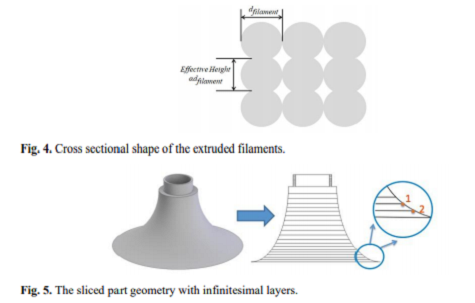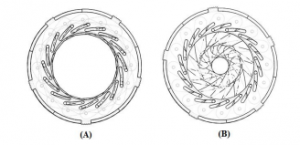You may not realize it, but the type of 3D printing nozzle you use does actually make a considerable difference in the quality of your 3D print. A group of researchers from the Department of Mechanical and Aerospace Engineering at the University of Florida recently published a paper detailing two types of nozzle that may be better for the FDM 3D printing process.
 In the paper, titled “A fundamental study of parameter adjustable additive manufacturing process based on FDM process” and published in the open access MATEC Web of Conferences publication series, the researchers explain that traditionally, it’s believed that an important part of a 3D printed part’s resolution is contributed by a small cross-sectional area of each material extrusion stand. But, smaller cross-sectional filaments have slower rates of extrusion, which increases build time.
In the paper, titled “A fundamental study of parameter adjustable additive manufacturing process based on FDM process” and published in the open access MATEC Web of Conferences publication series, the researchers explain that traditionally, it’s believed that an important part of a 3D printed part’s resolution is contributed by a small cross-sectional area of each material extrusion stand. But, smaller cross-sectional filaments have slower rates of extrusion, which increases build time.
There have many attempts to fix this issue, such as applying each layer’s maximal permissive thickness or using lower support volume to target a shell-like structure. But, the researchers note that there hasn’t been a lot of adjustment to the extrusion parameters to control resolution during the FDM process.
The abstract reads, “In Fused deposition modeling (FDM) process, there has been a confliction between high productivity and high quality of products. The product resolution is proportional to the flow rate of heated material extrusion, which directly affects the build time. To reduce the build time with acceptable resolution, the idea of parameter adjustable printing process has been introduced. The controllable extruder was modified and two types of diameter changeable nozzle have been designed. This work realizes different resolution building based on the part geometry during FDM process, which can efficiently assure the quality of products and improve the productivity at the same time.”
The diameter of an FDM 3D printer’s nozzle can not only affect the material extrusion rate, but also the resolution of a 3D print. Once the resolution has been determined, its corresponding extrusion parameters can be successfully calculated to determine the relationship between the parameters and the part’s geometry.
“In this paper, the nozzle diameter was chosen as the main changeable extrusion parameter,” the researchers explain. “The extruder of the printer was modified to fit the new process, which determined the extrusion parameters under the certain resolution. The relationship between the part geometry and needed resolution was derived and two kinds of diameter changeable nozzle were designed for the process.”
Viscous fluid flows are typically metered with positive displacement gear pumps, so the researchers used one in the 3D printer’s extruder for their study.
“The speed of the nozzle movement is assumed to be the same as the material extrusion speed for a reliable resolution,” the researchers said.
- Geometry of iris diaphragm parts: (A) base, (B) curved blades, (C) turning disc
- Top view of the nozzle’s maximum (A) and minimum diameter (B)
An optical component called an iris diaphragm has several thin, smooth blades arranged in such a way as to form a round aperture. Due to its controllable aperture diameter, this diaphragm is often used to limit how much light is transmitted to an imaging sensor in camera shutters. That made it a good choice for a component that can change a 3D printer nozzle’s diamater.
“Compared to the traditional extrusion printing nozzle, the iris-shaped nozzle can adjust the diameter easily and realize the changeable diameter during the printing process,” the researchers explained in the paper. “The multi-blades of iris diaphragm can guarantee the circular cross-sectional shape of the nozzle. It is feasible to change the diameter of the nozzle precisely and rapidly by utilizing electronic control system.”
But, even if an iris shape could change a nozzle’s diameter, it may also have some gaps around the round aperture, cause leaks during material extrusion, and the high temperature could even soften the blades and lead to damaged prints. That’s why the researchers conceived of a scroll model that would work “without setting the extra planes in the nozzle.”
Inspired by paper scrolls, the circular bottom of the scroll nozzle will become smaller as the shape is rolled, though it will continue to be round. That’s why a scroll model, with its easy diameter control, may be a better choice for a 3D printer nozzle with a changeable diameter than the iris diaphragm shape.
The researchers concluded, “So far, the theoretical model for the parameter adjustable FDM process has been built up. The extruder of the printer was modified using positive displacement gear pump for controlling the flow rate by changing rotation rate so that the resolution, which is represented by filament diameter, could be adjusted by the flow rate during the extrusion process under certain optimal extrusion speed. The desired filament diameter of each building layer was determined by the part geometry using either external-slope criterion or small-feature criterion.”
A few issues to be cleared up during future studies include mechanical performances and resolution of a part’s internal sections and challenges in material selection.
Co-authors of the paper are Qia Wan, Youjian Xu, and Can Lu.
Discuss this story and other 3D printing topics at 3DPrintBoard.com or share your thoughts below.
Subscribe to Our Email Newsletter
Stay up-to-date on all the latest news from the 3D printing industry and receive information and offers from third party vendors.
You May Also Like
HP & INDO-MIM Collaborate to Boost Metal 3D Printing in India
HP Inc. and INDO-MIM, a US- and India-based supplier of metal injection molding (MIM) powders and contract manufacturer, have announced that the two companies will collaborate to accelerate additive manufacturing...
New Report: Semiconductor Industry to See $1.4B in 3D Printing Revenues by 2032
“The semiconductor sector has become the most strategically significant area of global industry.” Truer words are hard to come by when it comes to the modern world, and they are...
One of US’s Largest Machine Tool Resellers to Offer Stratasys 3D Printing
In a key move for the additive manufacturing (AM) stalwart, Stratasys (Nasdaq: SSYS) has announced a strategic partnership with Select Additive Technologies, a division of Morris Group, Inc., which is...
3D Printing Unpeeled: Orbex Investment, IndoMIM and HP, Ultrasonic Waves
INDO-MIM has bought three HP Metal Jet S100 printers, operating two in India and one in Texas. This is a win for HP because the company has deep experience in...


































